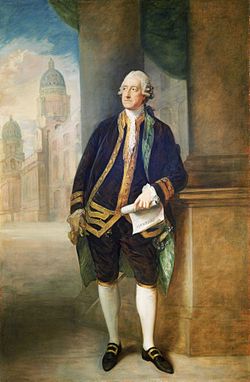| The Earl of Sandwich | |
|---|---|
 | |
| Artist | Thomas Gainsborough |
| Year | 1783 |
| Type | Oil on canvas, portrait |
| Location | National Maritime Museum, London |
Portrait of the Earl of Sandwich is a 1783 painting by the English artist Thomas Gainsborough depicting a full-length view of John Montagu, 4th Earl of Sandwich. [1] [2] Sandwich had recently left the post of First Lord of the Admiralty which he had held three times since 1748, having overseen British naval operations during the American Revolutionary War. Sandwich is shown against the backdrop of Greenwich Hospital and holds a plan of James Stuart's design for the infirmary completed in the 1760s during Sandwich's earlier term as First Lord. [3]
It was commissioned from Gainsborough by the current governor of the hospital Admiral Hugh Palliser as a gesture of thanks to Sandwich for his political patronage. It is in the collection of the National Maritime Museum. [3] A 1788 engraving by John Keyse Sherwin is in the collection of the National Portrait Gallery. [4]
